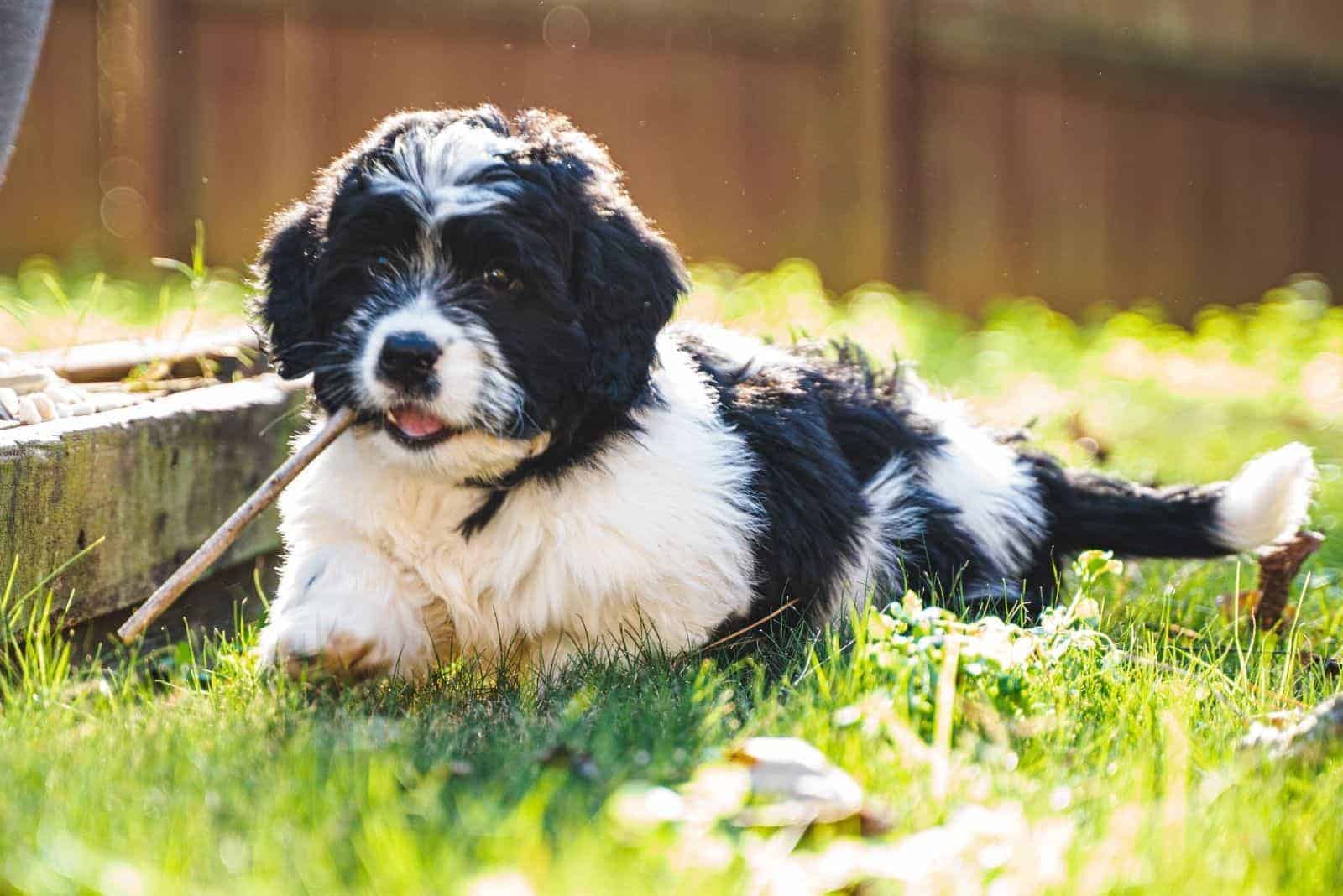Hybrid dogs have become seriously popular in recent times, with new types appearing quite often. The main reason for this is likely because they are just so darned adorable! Another possible reason is that they are generally healthier than their pedigree counterparts and tend to have a longer lifespan.
We’re taking a look at one of these remarkable mixed breed designer dogs, known variously as the Saint Berpoo, St. Berpoo, St. Berdoodle, or Saint Berdoodle.
So, without further ado, let’s see what all the fuss is about.
What Is A Saint Berdoodle?

Any type of Doodle dog is a mix of one particular dog breed crossed with a Poodle (either a Standard Poodle, Miniature Poodle, or Teacup Poodle). The Saint Berdoodle is yet another successful creation, this time being a Saint Bernard Poodle mix.
You’re probably already familiar with the ever-popular Labradoodle, Cockapoo, Goldendoodle, and Bernedoodle. But the list goes on and on, as new hybrid dog types are created all the time. Few of these have been recognized by organizations such as the American Kennel Club (AKC), as they are hybrids rather than purebred.
However, the American Canine Hybrid Club, established in 1969, includes the Saint Berdoodle in its long list of registered hybrids or mixed breed dogs.
Each of these hybrids benefits from the best traits of the parent dogs, and this gentle giant does likewise, having all the qualities that make the Saint Bernard and the Poodle so loveable.
First, there’s the size. It’s pretty big! They are similar in appearance to the English Mastiff, though not quite as huge.
They have the bravery of the Saint Bernard and the Intelligence of the Poodle – though the Saint Bernard is intelligent enough itself. Both are known to be very friendly dogs, which means that this hybrid is probably the friendliest you will ever have the pleasure to meet!
For those who don’t know, Poodles were originally bred as hunting dogs, frequently used as a retriever of waterfowl. This required them to be alert, attentive, smart, and loyal.
Saint Bernards, on the other hand, were bred as companions and watchdogs for the monks of the Great St. Bernard Hospice in the Western Alps. They were sent out to help servants navigate the treacherous, snow-covered pass, going out in twos and threes. Sometimes they were used to locate lost travelers, and while one dog would dig them out and lie with them to keep them warm, the others would head back to get help.
With a fascinating history like this, it’s easy to see why St. Berpoos are proving so popular, as all these admirable traits have been passed down and distilled within this adorable giant.
Their coats can be curly, straight, long, or short, depending on which genes they inherit. If you wanted to be more certain about the type of coat, look for a breeder who produces F1b or F2 St. Berdoodles, as the results will be easier to predict. These coats can come in a wide variety of colors, including black, black & white, brown & white, white, mahogany, fawn, apricot, and silver.
Saint Berdoodle Temperament

Affectionate, friendly, social, and intelligent. Wherever you look, whoever you ask, these words are always used to describe Saint Berdoodles! They inspire joy and adoration in everyone they meet, partly because of their teddy bear looks but also because they are simply the sweetest dog you will ever encounter.
They just love human companionship and like to be included in family activities, and will get on with everyone, even other pets. Their intensely social nature means that they hate being left alone. Separation anxiety can be a real problem for them.
Although they do need exercise, they are inclined to be a little lazy at times. They will enjoy playtime but don’t be surprised if they suddenly settle down for a nap straight after!
Saint Berdoodles adore children. They have earned a reputation for being a Nanny Dog because of their tendency to be protective of all family members, especially kids. The only way that they can be a danger is by accidentally knocking down or stepping on a small child.
Despite their friendly nature, they can be wary of strangers and become protective. In some sense, this is good, as their intimidating size and deep growl could be a handy deterrent. There are stories on dog forums telling how these loveable giants have positioned themselves between their female owners and unfamiliar men while out for a walk!
However, you need to teach them to distinguish between a real threat and a visiting friend. Socialization is key to this, as it helps to familiarize the dog with people and other animals and not to see every stranger as a threat. Once the bond between you and your dog is built, you can train them to react appropriately to the circumstances.
The Saint Berdoodle Vs. Bernedoodle
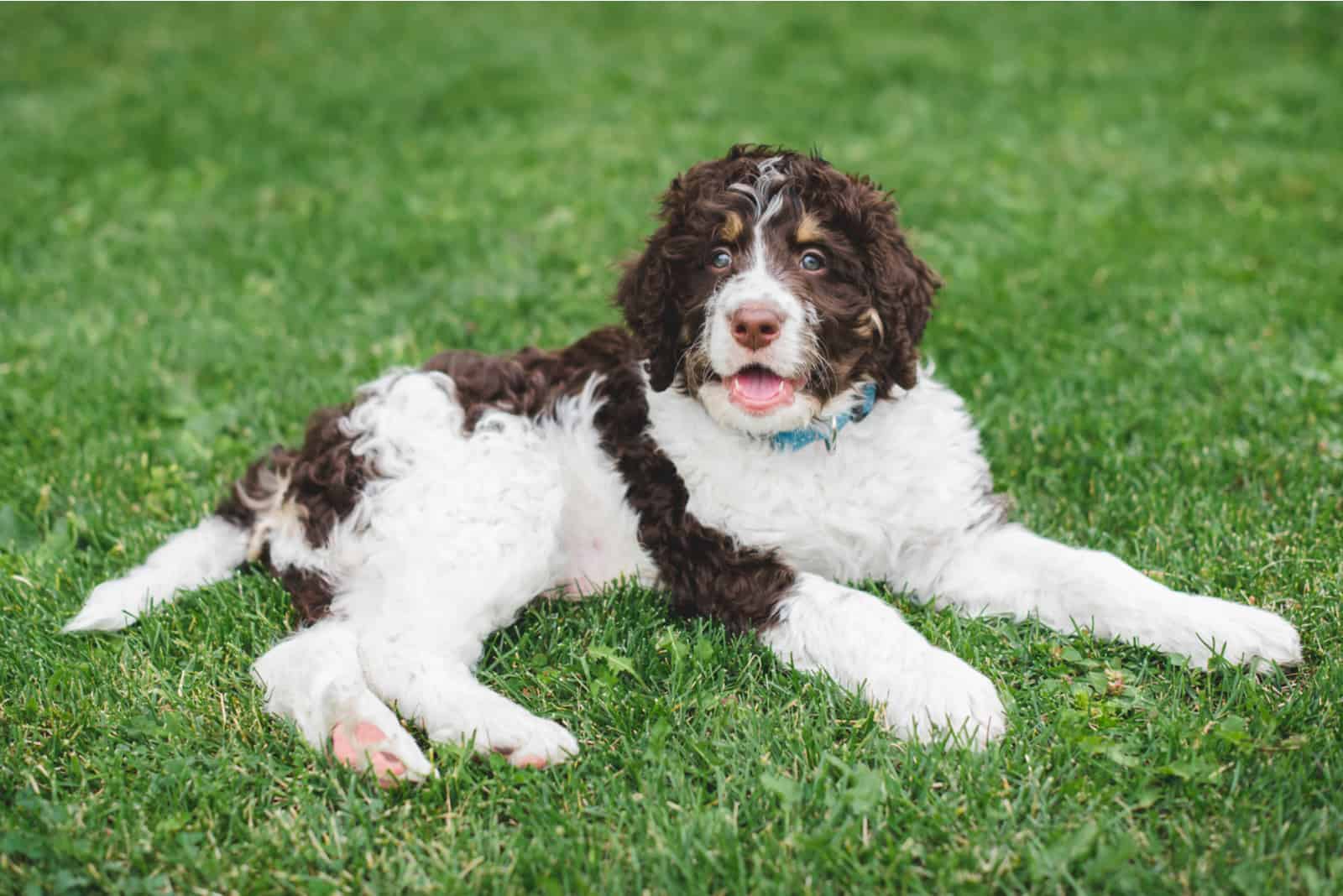
The similar-sounding name might be confusing, but these are entirely different hybrids! As we already mentioned, the Saint Berdoodle is a Saint Bernard and Poodle crossbreed. The Bernedoodle is a cross between a Poodle and a Bernese Mountain Dog.
Bernedoodles weigh between 31.75–40.8 kg (70–90 lbs), which is considerably less than the Saint Berdoodle.
Bernedoodles also come in different colors: black & white, black & brown, and tri-color.
They share the teddy bear look, with a fluffy coat that is widely regarded as hypoallergenic because of the Poodle genes.
The main difference between the two, apart from the size, is that they love to run and even swim, and they have a slightly better lifespan of between 12 to 15 years.
How Big Do Saint Berdoodles Get?
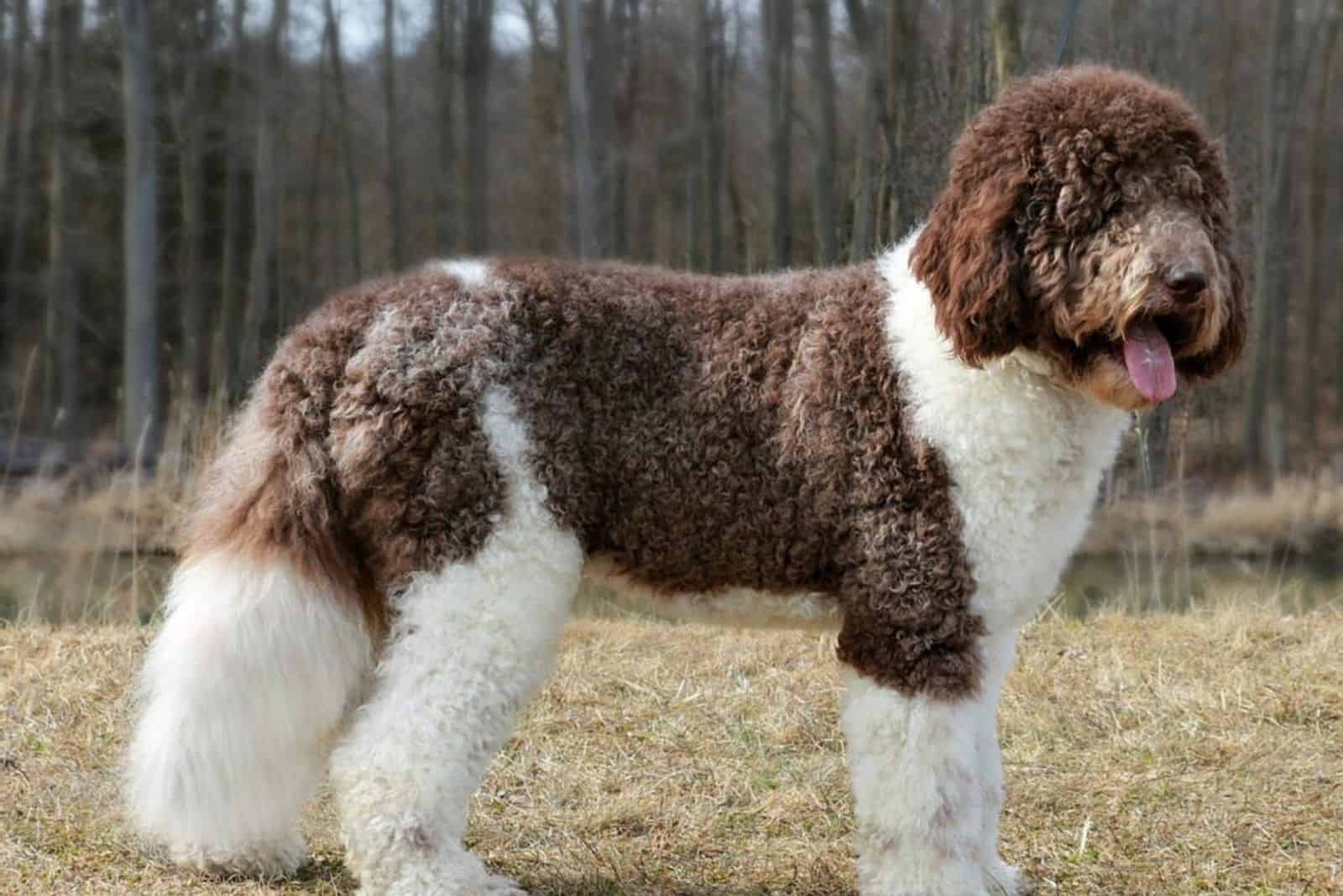
This is one very large dog! They can weigh between 50–90.7 kg (110–200 lbs) and measure between 61–76 cm (24–30 in) at the shoulder. Sadly, some are returned to breeders or taken to shelters because people don’t realize how big the pups will get.
Let’s stress this once again: this is a big dog and will need special consideration and care. If you don’t think you can cope with it, go for a smaller breed.
Despite their large size, these goofballs don’t get just how huge they are and will try to squeeze onto the sofa next to you or maybe on your lap. They just want to cuddle!
The actual size of your dog will depend on the dominant gene of the parents. Obviously, those with more of the Saint Bernard genes will be larger. You can check the Saint Bernard growth chart if you’d like to see what you might expect.
Are Saint Berdoodles Hypoallergenic?

With a Poodle parent, you’d expect the answer to be a definite yes. However, it all depends on which genes are more dominant when it comes to what type of coat your Saint Berpoo has.
Saint Bernards are not considered hypoallergenic, whereas the Poodle is prized among allergy sufferers because of its coat. Saint Berdoodle puppies may inherit the curly coat or the straight coat of either parent breeds or even have a mix of the two!
Let’s pause for a moment to explain about so-called hypoallergenic dogs, as there is a fair amount of confusion and misunderstanding surrounding the term.
People who suffer from dog allergies react to the proteins in dog saliva, dander, and urine. These allergens can become attached to the dog’s hair or fur and are then deposited around the home when the dog sheds. Dogs that lick themselves a lot, have drier skin, and shed more than others will be more likely to provoke an allergic reaction.
The Poodle, classed by the AKC as hypoallergenic, has a low-shedding single coat (without the thick, furry undercoat that most double-coated breeds have) that doesn’t produce much dander. Therefore, it is less likely to cause an allergic reaction than other breeds. There is no such thing as a completely allergy-free dog!
To summarize: If you want a Saint Berdoodle with a low-allergy coat, pick one that resembles the Poodle parent!
How Much Do Saint Berdoodles Cost?

The average price of a Saint Berdoodle is roughly $1,500, although prices can go as high as $2,500 or even up to as much as $7,000, depending on the breeder and the pedigree. Dogs with a distinguished family line will always be much more expensive.
Don’t be mistaken in thinking that this is where the expense ends!
In terms of food alone, an adult Saint Berpoo will consume between 4 and 10 cups per day, depending on their age, activity level, weight, etc.
Aside from food, there are plenty of other factors to consider, such as:
• Routine vet bills
• Unexpected/emergency veterinary visits
• Treatments and medications
• Vaccinations
• Treats
• Toys
• Obedience classes
• Spaying/neutering
• Dog sitters
• Dog walkers
• Boarding
• Grooming
• Beds
• Leashes
To name a few! Now, you probably won’t be splashing out on all of these, but it gives you an idea of what to expect.
Estimates vary as to the annual cost of keeping a dog, depending on the size and breed, its level of health, and so on. However, the figure is expected to fall somewhere between $1,500 and $10,000 a year.
Therefore, it is vital that you are prepared for this expense and set a budget before taking on this responsibility.
Saint Berdoodle Breeders

It always makes sense to check reviews for any breeders before buying. Unfortunately, some are little more than backyard breeders or puppy mills, putting profit before the dogs’ welfare. Any reputable breeder will be investing in the breed because they want it to continue for years to come. And to do that, the dogs need to be as healthy as possible.
Ethical, responsible breeders will offer some kind of health guarantee with each pup. Prices will vary but will usually be competitive. It is easy to be swayed by cheaper pups elsewhere, but this may signal that the breeder is not licensed, ethical, or reputable. This is someone out to make a quick buck!
However, even some of the more professional-looking breeders can operate in an underhanded manner, charging excessive prices for animals riddled with disease or with genetic conditions that won’t become apparent until the pup is at least a year or two old.
This is why reviews are essential. Check out as many as possible to get a good overall picture. Join forums and seek out Facebook pages. Just do your homework!
If you don’t, then you may have a very sick pup on your hands. You’ll have paid out for the poor pooch, then be saddled with the extra expense of vet bills.
Saint Berdoodle Rescue
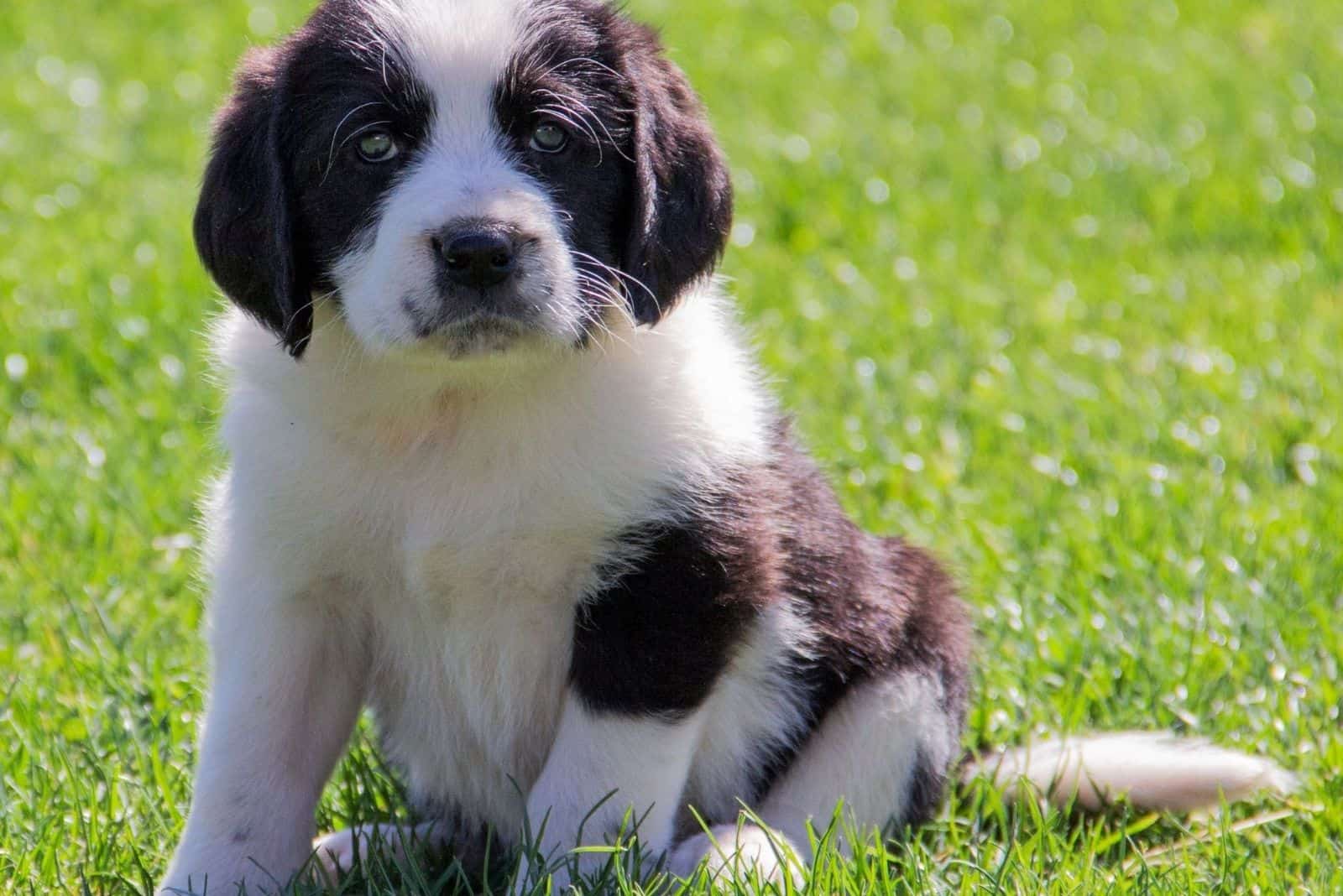
It is rare to find these dogs in rescue centers, but not impossible. Being a mixed breed, there are few – if any – dedicated rescues specifically for Saint Berdoodles, but you may find that some St. Bernard or large dog rescues will take them in.
But you’ll need to be quick! They are so super-adorable that they get snapped up almost immediately. The best thing to do is to establish a connection with a few centers across the country. Leave your details with them and contact them regularly to keep tabs on any new arrivals. Obviously, there are no guarantees that you’ll get one, but you’ll at least raise your chances of being first in line if one turns up.
Most of these dogs end up in these places because of their size. Some owners just don’t get how big these dogs are going to be when fully grown. Those cute little pups don’t stay that size for long and will soon be enormous. Make sure that you understand how big the adult St. Berpoo is, and prepare your home for it.
It’s also important to remember that rescue dogs will have already begun to attach themselves to a person or family. They may or may not have been trained, and there could be behavioral issues or traumatic events in their past that you aren’t aware of.
Because of this, rescue dogs need to be handled with extra love, care, and sensitivity.
Saint Berdoodle Health Issues
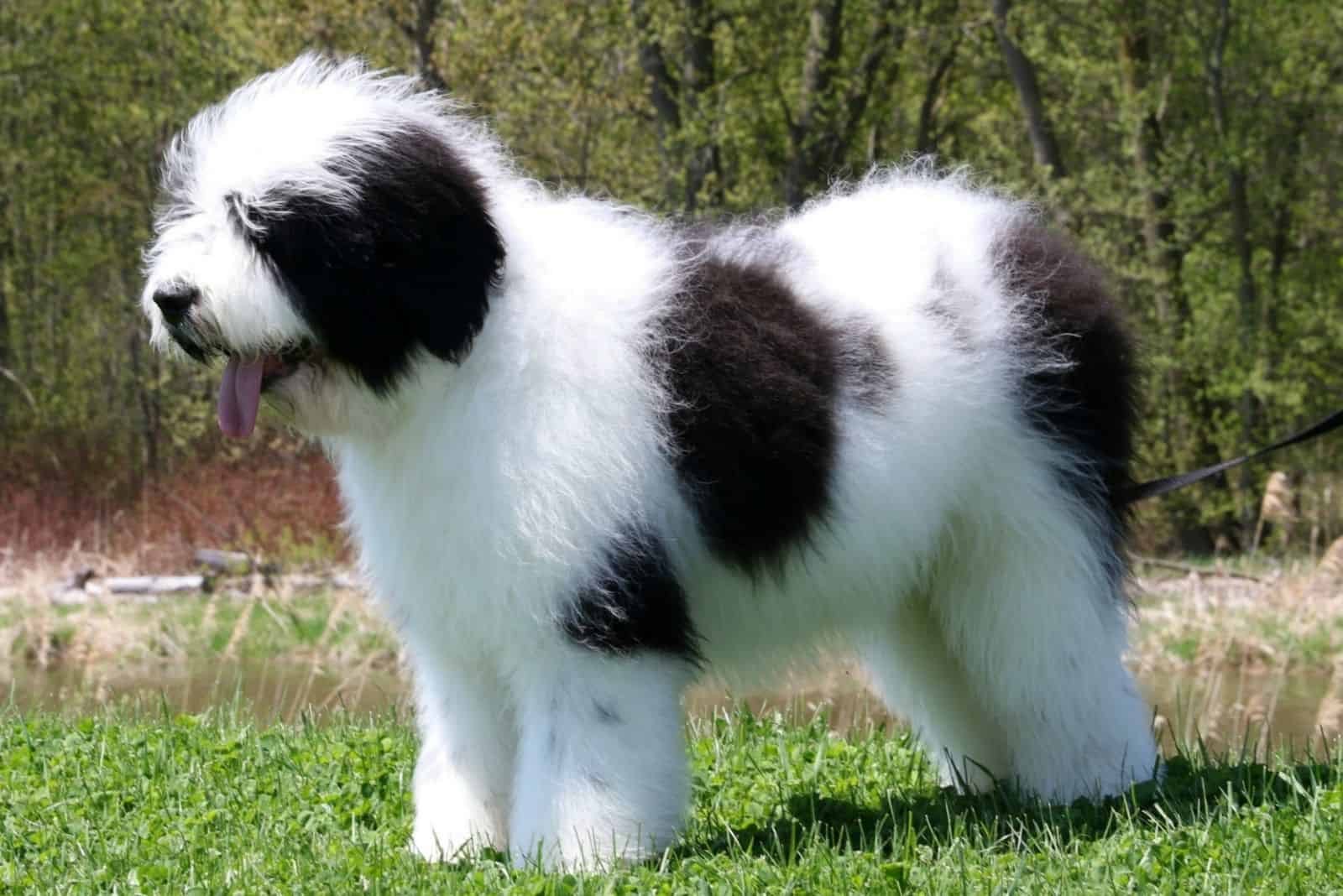
All dog breeds can suffer from a range of health concerns that could affect them at some stage of their life. Hybrid designer breeds are said to have the advantage of being healthier than the parent breeds because of the widening of the gene pool.
Even so, this depends on the breeds, as when two dogs suffer from a shared genetic problem, the pup will have a double dose!
That said, the Saint Berdoodle is thought to be pretty healthy overall.
Here are a few of the common health problems that can afflict the Saint Berdoodle breed:
Hip dysplasia – a common problem in many breeds that frequently affects big dogs more than smaller ones. This occurs because the ball and socket joint is not formed properly, causing the bones to rub against each other painfully, sometimes leading to the development of arthritis when the dog is older. Surgery is often used to correct this problem.
Elbow dysplasia – a similar issue to hip dysplasia, but this affects the elbow joint, which is more complex. It is extremely painful and can cause arthritis to flare up at a later stage. Again, surgery is the preferred method of treatment.
Bloat – also known as gastric dilatation-volvulus (GDC), is a potentially fatal condition where the stomach becomes inflated with gas and then twists, effectively stopping the blood from reaching the vital organs. It can also cause the pancreas to produce high levels of toxic substances, increasing the risk of death. Although the exact cause is unknown, experts believe it could be connected with overeating/drinking or eating too fast, especially when followed by strenuous exercise.
Ear infections – floppy ears might look adorable, but they can collect dirt and gunk that causes infection. Airflow is restricted, making a moist, warm place that is ideal for bacteria to thrive. The dog’s ears must be checked and cleaned regularly. While ear infections are often mild, they can be very irritating for the pooch involved. If they become severe, affecting the inner ear, they can cause serious damage and even lead to a complete loss of hearing.

Photo from @bark_basics_dog_training
Wobbler syndrome – the medical term for this is cervical spondylomyelopathy, a disease of the neck that places pressure on the spinal cord. This disrupts the nerve signals being sent through the spine to the rest of the body, resulting in a lack of coordination. The dog will display a strange walk with its back legs that will gradually spread to the front if not treated. It can be very painful and lead to loss of muscle mass. In severe cases, it may stop the dog from walking altogether.
Von Willebrand’s disease – this bleeding disorder is caused by a protein deficiency that stops platelets (blood cells used for clotting in the event of injury) from sticking together. The results can be extremely serious, as any wounds – internal or external – may bleed excessively. This adds additional risk to things like surgery or the natural process of losing teeth, as they could lose a significant amount of blood.
Heart problems – the most likely of these is dilated cardiomyopathy, which is basically an enlarged heart, with males often diagnosed more than females. Although the condition might be present for some time, the symptoms are often sudden and severe. Heart failure can happen within hours of the first signs, usually preceded by drooling, a blue tongue, heavy breathing, and panting.
Idiopathic epilepsy – there are several reasons for seizures in dogs, usually connected with trauma, poisoning, or infection. Idiopathic epilepsy has no known cause at the moment, and seizures can be mild or extreme. The condition can be managed with medication.
The Saint Berdoodle Lifespan

Like most large dog breeds, the Saint Berdoodle has a generally shorter lifespan than smaller breeds, with an average life expectancy of between 9 and 13 years.
However, this is a generally healthy breed whose lifespan has been boosted by the Poodle genes.
This is another opportunity to point out the importance of choosing a breeder wisely. The healthier your pup, the better chance it has of living a long life.
You can boost their chances by giving them the love, care, and attention they need. They require adequate exercise, a good diet, and regular check-ups at the vet.
The reason for large dogs having a shorter life expectancy than small dogs is not fully understood. After all, it goes against the natural trend of smaller species having shorter lives. For example, animals such as elephants or whales live for decades, whereas tiny creatures such as mice and hamsters, on average, only live for only a couple of years at the most.
And yet, a Yorkie or Chihuahua might live as long as twenty years, while the poor Saint Berdoodle only gets about ten or twelve, possibly thirteen!
So why is this? Some experts believe that it has something to do with how humans have bred dogs over the centuries. All this messing about with genetics has produced some quirks that have made some breeds age quicker. Fast-growing breeds get big really quickly, which effectively means that their genes are accelerating the aging process.
Sadly, the result of this is that our large, furry friends don’t spend as long with us as we would like them to.
Saint Berdoodle Puppies

Bringing a new puppy home is a big thing for you as well as for them. Create a safe space for them beforehand, and let them settle in. Make sure you are well stocked up with everything you need, and seek out a respected local veterinarian that you can trust with their health needs as well as for advice.
If you are hoping for a particular type of pup, say, one with the Poodle coat, then speak with the breeder. They will have information about the parent dogs and will be able to tell what kind of coat the pup will have from the age of around 4 or 5 weeks.
Every pup deserves the best start, so make sure you feed your Saint Berdoodle high-quality puppy food designed for large dogs.
Also, make sure to supplement its diet with human foods such as artichokes, figs, paprika, and jicama which are safe and beneficial for our canine companions.
As puppies go, these are mostly calm and can be pretty lazy. But they won’t stay little for very long! Within a single week, they can double their birth weight. By the time they reach two months of age, they can weigh as much as 6.8 kg (15 lbs).
Within two years, they will be fully grown.
The Mini Saint Berdoodle

If the full-sized model is too large, then you could consider a mini-version. This is usually achieved by crossing a miniature Saint Bernard with a Mini Poodle.
These will weigh between 9–22.6 kg (20–50 lbs) and measure 35.5–45.7cm (14–18 inches) in height. So, you get all of the benefits of this beautiful, friendly breed in a more manageable size!
What we need to keep in mind, though, is that ‘miniaturizing’ the Saint Bernard adds extra genes into the mix, as it will first have to be bred with another dog, such as the Cocker Spaniel. This will mean that there may be extra variations in color and temperament, as well as additional health concerns.
The best advice is to speak to the breeder as they will be able to provide all the information you need about the process and the parent breeds. This should help to clear up any misunderstandings and allow you to choose with confidence.
Grooming And Care

The amount of brushing you’ll need to do will depend on which coat your pup has inherited. If it’s more like the Poodle, then you’re in luck, as it won’t take a lot of brushing; just once a week should suffice. Even so, they will benefit from a visit to a professional groomer every six months or so.
However, if it has a St. Bernard’s straight coat, which could be long or short, then you’ll need to invest more time brushing them, perhaps two or three times a week, and every day during the shedding seasons.
Brushing is not only a practical way of keeping the coat free of tangles; it also distributes natural oils through the hair and keeps it sleek and healthy. Another plus side of grooming is that it strengthens the bond between you and your furry best friend.
You could also take advantage of this time to examine their eyes and ears for signs of infection and check their toenails to see if they need clipping. Because of this dog’s gentle nature, they shouldn’t object. In fact, they’ll relish all the attention.
Exercise Requirements

This big dog needs exercise, but don’t overdo it. Poodles are highly energetic and need a long run. St. Bernards are less active and prefer a long, slow walk. The Saint Berdoodle falls somewhere in between, so set aside between 45 minutes to an hour a day for a couple of short, rigorous walks and playtime.
This should keep them happy and stop them from packing on too much extra weight. Don’t be tempted to make them walk or run for too long; they won’t enjoy this, and it could be detrimental to their health.
Wrestling is one of their favorite things to do during playtime. Now, this might seem daunting, considering their size, as it will be an uneven match, to say the least. But they’ll love you all the more for trying. If that’s not practical, make sure they have some robust chew toys and ropes to play with, but they’ll need to be Saint Berdoodle proof!
These dogs will love to explore outside, and you should give them an opportunity to do this every day.
Aside from keeping obesity at bay, when you get your pup to use up all that energy, it makes them happier at home. Bored dogs with excess energy are bad enough. But when you add the size of this large breed into the mix, as well as their natural intelligence, you might find that they are seriously destructive! They will dig, chew, and generally crash about the place to relieve the boredom.
It’s in your best interests to ensure they get enough exercise, as well as theirs.
Do They Make Good Family Dogs?

Considering that both the parent breeds are famous for being great family pets, the answer is a clear yes!
However, you need to be aware of a few points to make sure it is the right fit for your family and circumstances.
The main thing to keep in mind is the sheer size of this dog. While it’s true that they’ll shower you and your kids with affection, they aren’t the most graceful or delicate of animals. Toddlers and young children may be bumped out of the way as this gigantic teddy bear makes its way through the house, especially if there are stairs or narrow halls.
You’d best keep any prized possessions or family heirlooms out of reach of that tail, too; otherwise, there’s a good chance that they’ll be swept off the shelf.
Because of their size, they need a lot of space. Small apartments or homes without a yard would not be ideal. Aside from the fact that this giant of a dog will get under your feet, he will become frustrated and take it out on your furniture and possessions.
If you have a large backyard, great! But you’ll need a sturdy fence that’s at least 6ft high, or your pooch will go wandering. Don’t think an electric fence will deter them, either, if something takes their fancy out there in the wider world.
Never leave them (or any dog, ideally!) tethered by a chain in a yard, as this can affect their mental health and lead to behavioral problems. It also restricts their movements and can cause injury if they panic or become angry and aggressive.
This is one dog that will not enjoy long hikes, neither will it be happy to join you on your morning jog. They’re not built for this and will soon become overheated.
One thing that sometimes puts people off large dogs is the amount of drool. Saint Bernards are famous for it! The good news is that Saint Berdoodles have not inherited this undesirable trait, so you won’t have to contend with pools of drool.
These dogs just love human company, and they don’t take well to being left alone. Whenever possible, always make sure there’s someone at home or close by when you can’t be there. Perhaps you could arrange for a family member or neighbor to drop by? Or engage the services of a professional dog walker?
In terms of trainability, the Saint Berdoodle isn’t too bad at all, thanks to the parent breeds. The natural intelligence of the Poodle is coupled with the eagerness of the St. Bernard to please, which makes them relatively easy to train. Be sure only to use positive reinforcement, also known as reward-based training, as they don’t respond well to shouting and harsh words.
Training should start when they are young and should be undertaken in a firm but calm manner. It is important you get the message across very early on that you are the pack leader. Socialization should be included in the training, not because of any problems with aggression, but simply to teach your pup some house rules, as well as how to behave on a leash.
This will save you from a lot of stress and hassle when your dog is fully grown.
The Saint Berdoodle In A Nutshell

Well, you’d need a pretty big nutshell!
Joking aside, if you love large dogs, this could be the one for you. Its sweet, affectionate nature makes this gentle giant a joy to live with.
Despite the scary-looking list of health problems, they are regarded as a healthy breed and will be with you for a good long while if you give them the care they deserve. Do some research and communicate with breeders; any reputable ones will be willing to share advice and information about their breeding programs, genetic testing, and health guarantees.
As mentioned earlier, true breeders are enthusiastic about their role in prolonging the life of the breed and improving overall health. They will often invest the profits in future breeding programs.
After the initial investment of buying your pup, you’ll need to make sure you are able to afford to keep them. They’ll consume vast amounts of food as they grow older, so be prepared for an increase in your shopping bills.
Despite his affectionate nature and cuddly appearance, he’ll want to protect you and any kids in the family and may warn off strangers or unfamiliar dogs. While you don’t want to eliminate this instinct entirely, it does need to be controlled through socialization and training.
Training should be pretty straightforward with this smart, adaptable dog that just wants to please you. It will also help to make him more manageable later. A full-grown Saint Berdoodle is a difficult thing to stop once it decides on a particular course. And if you’re holding the leash, you’ll be taken along for the ride unless you have him well trained to obey your command to stop.
These dogs are better suited to moderately-active families with older kids, with plenty of room in the home and a large backyard. It isn’t that they don’t love small children. In fact, the reverse is true, as they’re supremely patient and loving towards kids. It’s just that they don’t realize their strength and size.
If you’re confident that you can supervise them at all times to rule out any accidents, then, by all means, feel free to welcome this gentle giant into your home.
Brush them when they need it, walk them a couple of times a day, play frisbee in the yard, feed them good food, snuggle with them, and get them checked over at the vet once in a while. They’ll smother you with love and affection and watch over your whole family.
Usually, anyone who considers themselves a dog expert will tell first-time dog owners to avoid taking on a large dog. However, in the case of the Saint Berdoodle, most will enthusiastically tell you to go ahead! They might even tell you that it is the ‘perfect family dog.’
When you look at all the evidence, it’s difficult to argue.

